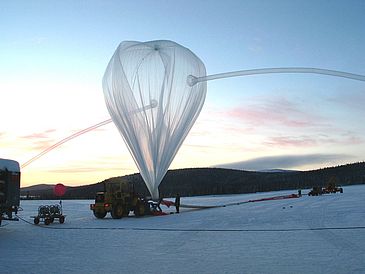This is now the seventh time students are able to take part in the German-Swedish student project REXUS/BEXUS (rocket/balloon experiments for University students). The project offers student teams the opportunity to carry out experiments with stratosphere balloons and research rockets. A great bonus for students of the University of Bremen is the close proximity to ZARM, the Center of Applied Space Technology and Microgravity, where the young researchers will be mentored. Applications to join the team can be submitted up to 21st October 2013. Program 2007 was initiated by the German Aerospace Agency (DLR) and the Swedish National Space Board (SNSB).
The experiments will encompass the thematic areas of atmospheric physics, balloon and space technology, radiation physics/biology, research in reduced gravity, remote sensing, and communication. While developing and carrying out the experiments, students will be under the guidance of two organizations: SNSB and the European Space Agency, ESA, thus opening up participation to students from all over Europe. In the DLR sub-project, students from German universities will be mentored by the Center of Applied Space Technology and Microgravity at the University of Bremen for a period of at least four years. Launching of the rockets and balloons will begin in the fall of 2014 or spring 2015 from the Esrange space center near Kiruna in the North of Sweden.
ZARM considers it a great honor to have been granted the project by the DLR space mission management. Embedded in the University of Bremen, for the past 24 years ZARM has been operating the Bremen drop tower, where research teams from all over the world come to conduct experiments under zero gravity. In the REXUS/BEXUS program, ZARM also has the central task of taking care of managing all the technical, scientific, and logistical aspects of the project – for up to ten student teams at the same time. “We see ourselves primarily as a service provider”, says ZARM project leader Simon Mawn. “I think our wide experience of working with the international research teams that use the drop tower must be an important reason why we were selected for the project.”
The application procedure for the new REXUS/BEXUS program run by DLR space mission management is now open. Those junior researchers eventually chosen will be involved in the entire process and detailed time scheduling of a real aerospace project. The REXUS experiments run over a period of 18 months, and BEXUS for about twelve months. Students will be accompanied throughout by the team at ZARM. The climax of the project comes with the launch of a research balloon and/or sounding rocket from the space launching station Esrange (European Space and Sounding Rocket Range) in Kiruna, in the North of Sweden. Mawn adds: “Another highlight is the so-called integration week, when for the first time all the German teams come together in the drop tower to work out the final details and set up their experiments. We are eagerly looking forward to supporting such a large number of bright young minds in developing and carrying out a series of interesting and above all airborne experiments”.
Information for applicants
REXUS/BEXUS (Rocket/Balloon EXperiments for university students) is a program run by the German Aerospace Agency (DLR) and the Swedish National Space Board (SNSB). Half of the payload capacity of the research rockets and balloons is reserved for German students, and half for students from Sweden. SNSB has additionally placed part of its payload share at the disposal of students from other member states of the European Space Agency.
Technical and organizational details as well as application forms can be found at:
the DLR’s REXUS/BEXUS website pages
the REXUS/BEXUS project homepage
Further information can be obtained by contacting:
Contact person at ZARM:
Simon Mawn
email simon.mawn@zarm.uni-bremen.de
Phone: +49 421 218-57758
Contact person for general press inquiries:
Birgit Kinkeldey
email birgit.kinkeldey@zarm.uni-bremen.de
Phone: +49 421 218-57755
You will also find a detailed description of the project in a DLR press release.

